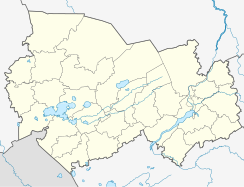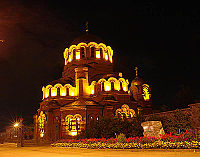Novosibirsk
| Novosibirsk (English) Новосибирск (Russian) |
|
|---|---|
| - City[1] - | |
 Views of Novosibirsk |
|
 Location of Novosibirsk Oblast in Russia |
|
|
|
|
|
|
|
|
|
|
| City Day | Last Sunday of June[2] |
| Administrative status (as of 2011) | |
| Country | Russia |
| Federal subject | Novosibirsk Oblast[3] |
| Administrative center of | Novosibirsk Oblast,[4] City of Novosibirsk,[3] Novosibirsky District[1] |
| Municipal status (as of December 2011) | |
| Urban okrug | Novosibirsk Urban Okrug[5] |
| Administrative center of | City of Novosibirsk,[citation needed] Novosibirsky Municipal District[6] |
| Mayor[8] | Anatoly Lokot[7] |
| Representative body | Council of Deputies[9] |
| Statistics | |
| Area (city) (2012) | 502.1 km2 (193.9 sq mi)[10] |
| Population (2010 Census) | 1,473,754 inhabitants[11] |
| - Rank in 2010 | 3rd |
| Population (2013 est.) | 1,523,801 inhabitants[12] |
| Density | 2,935 /km2 (7,600 /sq mi)[13] |
| Time zone | OMST (UTC+07:00)[14] |
| Founded | 1893[15] |
| City status since | January 10, 1904 [O.S. December 28, 1903][16] |
| Previous names | Novonikolayevsk (until February 12, 1926)[16] |
| Postal code(s)[17] | 630000–630992, 901073, 901077 |
| Dialing code(s) | +7 383[10] |
|
|
|
| Novosibirsk on WikiCommons | |
Novosibirsk (Russian: Новосибирск; IPA: [nəvəsʲɪˈbʲirsk]) is the third most populous city in Russia after Moscow and St. Petersburg and the most populous city in Asian Russia, with a population of 1,523,801 (2013 est.).[18] It is the administrative center of Novosibirsk Oblast as well as of the Siberian Federal District. The city is located in the southwestern part of Siberia on the banks of the Ob River adjacent to the Ob River Valley, near the large water reservoir formed by the dam of the Novosibirsk Hydro Power Plant.[19] and occupies an area of 502.1 square kilometers (193.9 sq mi).[10] The city is informally known as the "Capital of Siberia."
Contents
History[edit]
Novosibirsk, founded in 1893[15] at the future site of a Trans-Siberian Railway bridge crossing the great Siberian river of Ob, first received the name Novonikolayevsk (Новониколаевск),[16] in honor both of Saint Nicholas and of the reigning Tsar Nicholas II in place of Krivoshchekovskaya village, was founded in 1696. The bridge was completed in the spring of 1897, making the new settlement the regional transport hub. The importance of the city further increased with the completion of the Turkestan-Siberia Railway in the early 20th century. The new railway connected Novosibirsk to Central Asia and the Caspian Sea.[20]
At the time of the bridge's opening, Novonikolayevsk hosted a population of 7,800 people. Its first bank opened in 1906, with a total of five banks operating by 1915. In 1907, Novonikolayevsk, now with a population exceeding 47,000, was granted town status with full rights for self-government. The pre-revolutionary period saw the population of Novosibirsk reach 80,000. During this period the city experienced steady and rapid economic growth, becoming one of the largest commercial and industrial centers of Siberia and developing a significant agricultural processing industry,[21] as well as a power station, iron foundry, commodity market, several banks, and commercial and shipping companies. By 1917, Novosibirsk possessed seven Orthodox churches and one Roman Catholic church, several cinemas, forty primary schools, a high school, a teaching seminary, and the Romanov House non-classical secondary school. In 1913, Novonikolayevsk became one of the first places in Russia to institute compulsory primary education.[20]
The Russian Civil War took a toll on the city, with wartime epidemics, especially typhus and cholera, claiming thousands of lives. In the course of the war the Ob River Bridge was destroyed and for the first time in its history the population of Novonikolayevsk began to decline. The Soviet Workers' and Soldiers' Deputies of Novonikolayevsk took control of the city in December 1917. In May 1918, the Czechoslovak Legions rose in opposition to the revolutionary government and, together with the White Guards, captured Novonikolayevsk. The Red Army took the city in 1919, retaining it throughout the rest of the Civil War.[20]
Novonikolayevsk began reconstruction in 1921 at the start of Lenin's New Economic Policy. It was a part of Tomsk Governorate and served as its administrative center from December 23, 1919 to March 14, 1920.[citation needed] Between June 13, 1921 and May 25, 1925, it served as the administrative center of Novonikolayevsk Governorate, which was separated from Tomsk Governorate.[citation needed] The city was given its present name on September 12, 1926.[16]
When governments were abolished, the city served as the administrative center of Siberian Krai until July 23, 1930, and of Western Siberian Krai until September 28, 1937, when that krai was split into Novosibirsk Oblast and Altai Krai.[citation needed] Since then, it has served as the administrative center of Novosibirsk Oblast.[citation needed]
One of the best examples of the early Soviet history is the Monument to the Heroes of the Revolution. It is located right in the center of the city and was one of the main historic sites (essentially every child had to visit the monument on school field trips during Soviet years). Then it was neglected in the 1990s and as a result somewhat ironically it turned out to be one of the best preserved Soviet-era sites.[citation needed]
During Stalin's industrialization, Novosibirsk secured its place as one of the largest industrial centers of Siberia. Several massive industrial facilities were created in there, including the 'Sibkombain' plant, specializing in the production of heavy mining equipment. Additionally a metal processing plant, a food processing plant and other industrial enterprises and factories were built, as well as a new power station. The Great Soviet Famine saw the influx of more than 170,000 refugees to Novosibirsk. The new arrivals settled in barracks at the outskirts of the city, giving rise to slums such as Bolshaya Nakhalovka, Malaya Nakhalovka, and others.[20]
Rapid growth and industrialization were the reasons behind Novosibirsk's nickname: the "Chicago of Siberia".[22]
Tram rails were laid down in 1934, by which time the population had reached 287,000, making Novosibirsk the largest city in Siberia. The following year the original bridge over the Ob River was replaced by the new Kommunalny bridge.[20]
Between 1940 and 1942 more than 50 substantial factories were crated up and relocated from western Russia to Novosibirsk in order to reduce the risk of their destruction through war, and at this time the city became a major supply base for the Red army. During this period the city also received more than 140,000 refugees.
The rapid growth of the city prompted the construction during the 1950s of a hydroelectric power station with a capacity of 400 megawatts,[23] necessitating the creation of a giant water reservoir, now known as the Ob Sea. As a direct result of the station's construction vast areas of fertile land were flooded as were relic pine woods in the area; additionally, the new open space created by the reservoir's surface caused average wind speeds to double, increasing the rate of soil erosion.[20]
In the 1950s, the Soviet Government directed that a center for scientific research be built in Novosibirsk, and in 1957 the multi-facility scientific research complex of Akademgorodok was constructed about 30 kilometers (19 mi) south of the city center. The Siberian Division of the Academy of Sciences has its headquarters in Akademgorodok, and the town hosts more than 35 research institutes and universities, among them Novosibirsk State University, one of the top Russian schools in Natural Sciences and Mathematics. Although it possesses a fully autonomous infrastructure, Akademgorodok is administered by Novosibirsk.
On September 2, 1962, the population of Novosibirsk reached one million. At that time, it was the youngest city in the world with over a million people. Novosibirsk took fewer than seventy years to achieve this milestone.[24]
In 1979, work began on the Novosibirsk Metro Transit System, culminating in the opening of the first line in 1985.[20]
On August 1, 2008, Novosibirsk was in the center of the path of a solar eclipse, with a duration of 2 minutes and 20 seconds.
Administrative and municipal status[edit]
Novosibirsk is the administrative center of the oblast[4] and, within the framework of administrative divisions, it also serves as the administrative center of Novosibirsky District,[1] even though it is not a part of it.[3] As an administrative division, it is incorporated separately as the City of Novosibirsk[3]—an administrative unit with the status equal to that of the districts.[citation needed] As a municipal division, the City of Novosibirsk is incorporated as Novosibirsk Urban Okrug.[5]
Demographics[edit]
According to the Federal State Statistics Service, in April 2013 the number of residents overstepped the mark of 1.5 million and amounted to 1,523,801 residents.[12] As of the 2010 Census, the population of the city was 1,473,754.[11]
People of over eighty ethnicities and nationalities reside in Novosibirsk. The largest groups are Russian, German, Ukrainian, Tatar, Jewish, and Belorusian.[25]
Ecology[edit]
Flora[edit]
The most well-known trees native to Novosibirsk are birch, pine, and aspen. Some mountain ash, hawthorn, spruce, and fir are also present. European species of apple, ash, elm, linden, and oak have been successfully introduced.
Fauna[edit]
Large mammals native to the Novosibirsk area include the brown bear, reindeer, moose (elk), wolf and fox. Also present are wolverine, ermine, marten, weasel, and polecat. The predators among them are supported by populations of beaver, hare, mouse, hamster, vole, shrew, squirrel, and chipmunk. More than 350 species of birds have been recorded in the area. On the other hand, only a few cold-blooded vertebrate species live on land, but they include the venomous adder and the swift grass snake. Perch and carp are prominent among the fish, of which there are more than thirty species. The carp often host a dangerous parasite, the liver fluke. Ticks in the area are frequent carriers of viral encephalitis.
Geography[edit]
Location[edit]
The city stands on the banks of the Ob River in the West Siberian Plain. To the south of the city lies The Priobskoye Plateau.
Climate[edit]
The weather in Novosibirsk is like the rest of typical Siberia, with a clear sky and far below freezing winter temperatures, making Novosibirsk the coldest substantially (>1 million) populated city on Earth, according to average winter temperatures. The reason for these temperatures is the absence of nearby ocean, the Ural Mountains, barring Atlantic air masses from reaching Siberia, and the lack of tall mountains at the north of Novosibirsk, that could have held back freezing Arctic winds. In fact, Novosibirsk is the second farthest substantially populated city from the ocean, the first being Urumqi, China
The climate is humid continental (Köppen Dfb), with warm summers and severely cold winters. Snow is frequent, falling on almost half of all winter days, but individual snowfalls are usually light. On average temperatures range in summer from +15 °C (59 °F) to +26 °C (79 °F) and in winter from −20 °C (−4 °F) to −12 °C (10 °F). However, winter temperatures can go as low as −30 °C (−22 °F) to −35 °C (−31 °F), and summer temperatures can go as high as +30 °C (86 °F) to +35 °C (95 °F). The difference between the highest and lowest recorded temperatures is 88 °C (158 °F). Most days the weather is sunny, with an average of 2,880 hours of sunshine per year, but heavy rain is possible in summer.
Travelers coming from countries with mild climates may find Novosibirsk’s winter tough, but it may not be extraordinary for those from northern countries. At times, bitter cold may hold for some days, but temperatures of −40 °C (−40 °F) and lower do not occur every year. In the springtime, streets and roads become dirty as a result of mud and melting snow, while the weather is still cold.




